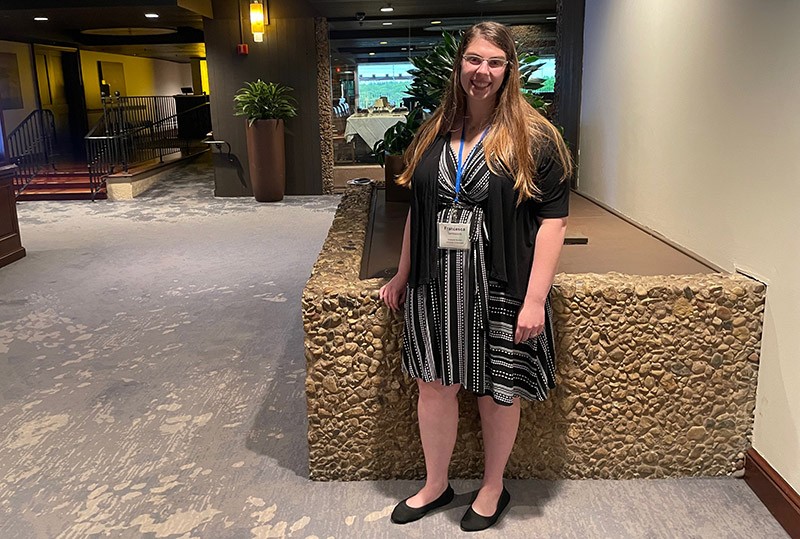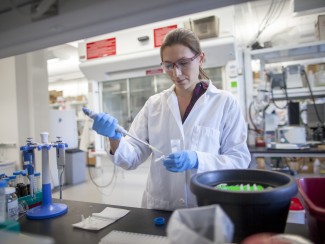
“We know more about Saccharomyces cerevisiae, or brewer’s yeast, than just about any other organism,” says Francesca Gambacorta, a graduate student in Brian Pfleger’s lab at the Great Lakes Bioenergy Research Center.
It’s this knowledge of Saccharomyces, used by humans for generations to leaven dough and ferment beverages, that Gambacorta uses to coax the versatile microbe into converting bioenergy crops into isobutanol. The energy-packed molecule, currently made from petrochemicals, is valued because of its versatility as a drop-in fuel or – when upgraded – jet fuel or diesel.
For her accomplishments both in and out of the lab, Gambacorta has received the 2022 Jennifer L. Reed Bioenergy Sciences Award.
The accolade, now in its fifth year, is given to GLBRC women graduate students, postdoctoral fellows, and junior scientists who show leadership through research excellence while serving the Center through other activities, including outreach in the community. The award is named in memory of Jennifer Reed, who was a project lead in GLBRC’s earliest stages and won numerous national awards for her leadership in science before passing away in 2020 after a long battle with cancer.
“It's a true honor to be awarded this award in memory of Jennie,” says Gambacorta, who worked closely with Reed’s lab. “While she wasn't my advisor, I could tell she was very passionate about science. And she always asked the good questions. In her memory, I hope to continue to be like that.”
Gambacorta’s advisor, Brian Pfleger, Jay and Cynthia Ihlenfeld Professor of Chemical and Biological Engineering, says she is a natural leader. “Whether you're talking about how she takes charge of non-research duties in the lab or how she's successfully managed a project involving six GLBRC-PIs, Francesca has demonstrated that she is ready to guide research as an independent scientist.”
“Francesca has taken advantage of the interdisciplinary nature of GLBRC and developed an impressive set of systems biology, synthetic biology, and bioengineering skills. This combination is what Jennie strove to instill in her students,” he adds.
Gambacorta’s path to microbial engineering began with aspirations of a medical career, but after an undergraduate internship in a pathology lab, she knew a stethoscope wasn’t in her future. It was another internship, this time at Argonne National Laboratory, that Gambacorta found her passion in studying microbes. “The work is much more relatable for me because the organisms that I work with we see every day in our bread and in our beer… and making a hypothesis and testing it out is much easier than with humans,” she says.
 While searching for graduate schools, she found Pfleger, whose work at the GLBRC focuses on metabolic engineering of microbes to make biofuels. During her interview, she also met Chris Hittinger, who advised her to join Pfleger’s GLBRC pursuits because of the resources a large, interdisciplinary research center could provide. But the experience has turned into much more.
While searching for graduate schools, she found Pfleger, whose work at the GLBRC focuses on metabolic engineering of microbes to make biofuels. During her interview, she also met Chris Hittinger, who advised her to join Pfleger’s GLBRC pursuits because of the resources a large, interdisciplinary research center could provide. But the experience has turned into much more.
“The GLBRC community has been really great,” says Gambacorta. “All the people I’ve talked to here are welcoming. They want to talk to you and to hear about your research. Even if the science isn't their background, they want to find a way to help you. And that's just really refreshing.”
Since joining Pfleger’s lab, Gambacorta has worked on building a strain of brewer’s yeast, normally an ethanol-producing powerhouse, that can produce isobutanol instead. “It’s difficult to change the metabolism of something that has evolved for millions of years to do one thing. And I’m really trying to understand the minimum modifications needed to make the switch.”
In a recent publication, for example, Gambacorta and a team of GLBRC colleagues found that housing Saccharomyces’ isobutanol-producing enzymes in the yeast’s mitochondria, the powerhouse of the cell, rather than in the cell’s open spaces, improved fuel production nearly four-fold. “This study was really comparing different engineering strategies, and now we know which one is the best one to start building the next generation of the strain,” says Gambacorta.
Now, as she nears the home stretch of her Ph.D., Gambacorta is grateful for the time she’s had outside the lab, too. “I've gotten the chance to do a lot of Engineering Expos and other outreach activities with kids. I want them to know that they can do whatever they want in their career,” she says. “I didn’t have a strong woman role model in the sciences, so I hope I can be a role model to them.”
And as for those young scientists? Gambacorta has a few words of advice: “Don't ever feel like you can't do something. Try something. And if you don't like it, move on. If you don't have a good experience with the people you work with, you can find better people, and you can move on to the next opportunity.”
“Getting a Ph.D. has taught me to be a more patient person and to try to look at the best outcome of things,” she adds. “Because, you know, sometimes experiments just don't work. And you have to learn how to overcome that.”




